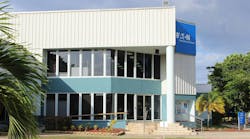It's been a long-time coming, but it's finally here. No more pay more now for future savings. No more do it because it feels good, not because it's profitable.
The energy-conservation market is one of the most exciting market opportunities in the history of the electrical wholesaling industry, and it's there for the taking. Surprisingly few electrical distributors or independent manufacturers' reps have positioned themselves as the energy gurus in their local markets. Perhaps they don't want to mess with the formula that's worked for so many years and are content pulling a few points of profit out of high-volume orders for traditional electrical products. That's a mistake, because it's really not much of a stretch for most distributors and reps to take advantage of the market opportunities in the energy arena. Why? Here are the key drivers.
Green is good
Saving energy is in, this time hopefully for good. Gas prices remain historically high, and uncertainty about the Middle East as a dependable long-term supply of oil has never been higher.
It's the law
State and federal legislation offer tax incentives for the installation of energy-efficient lighting.
LEED as a badge of honor
Despite frustrations over the complex certification process, architects and building owners want (and in some municipalities are being forced to) design LEED-certified buildings.
Free money
Utility-rebate programs are in high gear and provide additional financial incentives to end-users and building owners who install energy-efficient lighting equipment, variable-speed drives, motors, solar water heaters, photovoltaic panels and other products.
New stuff
Just as many consumers are starting to realize that installing compact fluorescent lamps (CFLs) is a good investment, light-emitting diodes (LEDs) are being developed that will one day offer four times the lamp life in a dazzling array of applications.
It's tough to keep up with all of these changes. To help keep you current, the next few pages summarize some of the more interesting, outlandish and just-plain fascinating things now happening in the energy conservation arena.
Using a Headquarters to Showcase Energy Efficiency
While Hubbell Lighting's new 175,000-square-foot headquarters in Greenville, S.C., houses its Lighting Solutions Center, the entire building is actually a classroom where lighting professionals can learn about energy-efficient lighting products.
The facility is lit by lfixtures from the company's 16 brands and is up for LEED Silver certification from the U.S. Green Building Council, Washington, D.C., for its energy-efficient design. Along with utilizing the latest in energy-efficient lighting, the building saves energy with a state-of-the-art HVAC system, the use of recycled building products wherever possible and a massive, four-story “glass curtain” wall that allows for the use of daylighting systems.
Scott Muse, group vice president, Hubbell Lighting, is justifiably proud of his group's $41 million dollar investment in the building, and on July 10-11 he entertained more than 20 business journalists at the company's new training center, which will offer reps, specifying engineers, contractors, distributors and other industry professionals a new lighting resource. Muse hopes to eventually educate 6,000 to 10,000 lighting professionals annually at the facility.
Earlier this year, Mark Lien, a 30-year lighting educator with 17 years of experience managing lighting educations center, came to Hubbell Lighting to manage the Lighting Solutions Center. Prior to accepting his new position, Lien taught in and managed Cooper Lighting's industry education facility. He helped design the new Hubbell facility so it would offer students the opportunity to do side-by-side comparisons of different lighting systems and utilize customizable kiosks to highlight the design opportunities in several hot areas in the lighting market: life safety, light pollution, daylighting and solid-state lighting.
Crowd Farms: Harvesting the Power of People
Everyone hates crowds — except two graduate students at the Massachusetts Institute of Technology who are experimenting with a concept that could utilize the mechanical movement of hundreds of people to produce electrical power. If their concept becomes a reality, Manhattan's bustling crowds, fans at sporting events, concert attendees and shoppers at shopping malls will produce electrical power. According to a recent report on www.msnbc.com, the students, James Graham and Thaddeus Jusczyk, have already proved that the simple act of sitting on a stool can generate enough power to turn on four LED lights.
Graham and Jusczyk base their theory in part on the concept of “piezoelectricity,” where an electrical charge is created when materials are put under stress. In its most basic form, piezoelectricity powers bicycle lights and hand-crank radios. With crowd farms, mechanical energy would be converted into electricity on a much larger scale. The www.msnbc.com report said blocks embedded in a spongy floor would move under the weight of humans walking (or dancing) on it, and that this movement would be converted in to electrical current by a dynamo. In April, the students' conceptual design won top honors in a competition sponsored by the Switzerland-based Holcim Foundation for Sustainable Construction.
NYC High School Students Pitching CFLs
Lighting manufacturers, electrical distributors, independent reps and other electrical professionals aren't the only ones who want to promote energy efficiency. Several high school students from New York City are helping low-income residents save money by switching over to compact fluorescent lamps.
RelightNY, the organization they founded, helps educate and encourage people to take action and live in ways that protect the environment. Bernie Erickson, one of the electrical market's best-known energy crusaders, heard about RelightNY and pitched in to help their cause earlier this year. Erickson, Northeast division manager for American Light/Facility Solutions Group (FSG), and his son, Matthew, loaded an American Light van with lamps supplied at special pricing from Philips Lighting, a RelightNY sponsor, and drove it to the New York students. The lamps were used at a HELPUSA housing complex. HELPUSA is a provider of homes, jobs and services for the poor.
“I really admire these boys for taking a stand on this issue,” says Erickson. “The culture here at Facility Solutions Group is based on helping others where we can, and we are glad to play a small part in the boy's efforts.”
To learn more about RelightNY, check out an archived television clip filmed by NBC News and aired on Tuesday, May 8 in the New York metropolitan area. Entitled “Going Green,” the segment covered the goals and objectives of RelightNY and the benefits of compact fluorescent lighting. It can be viewed on the web at www.wnbc.com/goinggreen/index.html.
McDonald's Wants to Super-size Energy Savings
When you have 30,000 locations in more than 100 countries, every watt saved is important. That's why McDonald's, Oak Park, Ill., is installing intelligent networking systems in its far-flung empire of burger joints. The networking systems from Echelon Corp., Palo Alto, Calif., utilize power-line networking technology, which means they operate over a building's existing wiring system, eliminating costly rewiring. The systems provide communication and data exchange between various pieces of kitchen equipment such as grills, fryers and soft-drink dispensers. This will allow local McDonald's franchise owners to save energy in their restaurants by controlling electrical loads more precisely. For instance, store managers can now automatically shut down electrical loads when they aren't needed, cycle electrical loads when possible, or slow down exhaust fans when the restaurants aren't as busy.
According to a Wall Street Journal report, McDonald's spends more than $1 billion annually worldwide on energy to power its restaurants, and they hope the new Echelon systems will slash their energy bills by at least 10 percent. That report said each McDonald's restaurant uses up to 500 kilowatts annually, at a cost of $40,000 to $50,000.
Lighting Job at Toronto Art Museum Wins 2006 GE Edison Award
The Gardiner Museum of Ceramic Art in Toronto is known in museum circles throughout the world for its collection of ceramic art. It's now on the “must-see” lists of lighting junkies, too, after winning the 2006 GE Edison Award. The lighting design by Suzanne Powadiuk, Suzanne Powadiuk Design, Inc., Toronto, illuminates the 23-year-old museum's new third-floor gallery and renovated lobby. Her award-winning design used knife-edge slots to organize and contain the components of the lighting design. At the entrance, the slots house continuous recessed lensed luminaires with GE 32W T8 Starcoat Ecolux 3,000K lamps. The new third-floor gallery provides exhibit space for both large and small ceramic pieces. A track system sits neatly up in the slots, and low-voltage, adjustable, lockable track heads with GE ConstantColor Precise MR16 lamps are used for exhibit lighting. To light smaller objects, framing projectors with Q71MR16/C/NSP15 lamps are used. At night, GE F32T8/SPX30/ECO lamps create a glow behind the sandblasted glazing.
Says Powadiuk, “With a limited number of lamp and luminaire options and dimming control systems, the user has been given a cost- and energy-effective, easily maintained lighting solution that addresses the varied needs of the public, restaurant and exhibition spaces.”
School Aces LEED Ranking
When school administrators at Sidwell Friends School in Washington, D.C., considered an upgrade of its middle school building, they decided it should live up to the school's Quaker ideal of environmental stewardship. To offer a learning environment that would increase the productivity of students and faculty, they decided that the building would have to be transformed into a LEED Platinum-certified facility.
They accomplished their goals in the $21 million construction project with the help of a lighting system designed by Benya Lighting Design, Portland, Ore., and the EcoSystem lighting control system manufactured by Lutron Electronics Co, Inc., Coopersburg, Pa. The Sidwell School was certified as LEED Platinum in October 2006, the first school in the nation to achieve this certification. Lighting energy consumption has been cut by 92 percent, and overall energy use has been reduced by 55 percent.
From its inception in 1883, this private independent school, serving pre-K through 12 on two campuses in Washington, D.C. and Bethesda, Md., has taught hundreds of students from the area, including children of U.S. presidents. As the facility manager for the school since 1981, Steve Sawyer must accommodate a variety of individual security needs for these high-profile families while, at the same time, provide a comfortable learning environment for teachers and students alike. On top of these duties, Sawyer recently was given an additional mandate: The middle school building had to set an example for environmental consciousness, exceeding the eco-friendly standard of every other secondary school in the country. Ground was broken in June 2005 and the project (a renovation of 37,000 square feet and a new 39,000-square-foot addition) was completed in September 2006. The project incorporated a variety of sustainable design features, including the following:
-
Lutron's EcoSystem lighting control solution provides energy-efficient fluorescent lighting, integrating daylight sensors, occupancy sensors and dimming ballasts.
-
A light shelf incorporated into the faÇade transmits daylight deep into the building while shading the corridors from direct sun.
-
Exterior walls of the addition and third floor of the existing building are sheathed with western red cedar cladding, sunscreens and high-performance windows.
-
Five percent of the overall building's electrical load is to be generated by photovoltaic panels.
Depending on their proximity to the windows, EcoSystem sensors dim rows of lights to different levels to take advantage of natural light while providing an even illumination in the room. A light shelf and the EcoSystem work in tandem to achieve energy efficiency in corridors and elsewhere in the building.
“It's been a lot of work for us,” says Sawyer. “But the results have been gratifying for everyone. Virtually every design feature took environmental responsibility into account and that, in turn, sends the right message to the kids who attend here.”
Down on LEED
Not everyone is happy with the LEED certification program. Two Aspen, Colo., builders say the program is way-too-complicated and costly. In their epic 7,100-word rant, “LEED Is Broken; Let's Fix It” (published at www.igreenbuild.com in 2005), Auden Schendler and Randy Udall said the certification process typically adds 1 percent to 5 percent to a building's budget.
“When LEED was launched, the hope was that it would transform the design and construction of commercial buildings,” they said in the study. “But today, for many reasons, LEED is fast becoming its own worst enemy. The program's early bloom is fading. Green building has a robust future, but LEED may not.”
By The Numbers
1,004 Buildings
The number of buildings certified by the U.S. Green Building Council, according to an article in the East Bay Business Times. That article said 48 buildings are certified at the platinum level; 283 are certified gold; 310 are silver and 363 at the bronze or “certified” (the new category name) level. In that article, Ashley Katz, a Green Building Council spokesperson, said Seattle ranks first with 31 certified projects, followed by Portland, Ore. (29), Chicago (26), Pittsburgh (22), Atlanta and Grand Rapids, Mich., (19 each), Washington, D.C. (18) and Austin, Texas (12).
2.4 Kilowatts
The amount of power produced on a sunny day by the photovoltaic panels powering the first LEED Platinum- certified house in the world. Owned by Steve Glenn, the founder of Web software firm People Link Inc., the four-bedroom, 2,500-square-foot house in Santa Monica, Calif., gets 80 percent of its power from the sun, and Glenn can sell any surplus power that he generates back to the utility. The system cost $12,000 to install after $13,000 in California's solar rebates and federal tax credits. Light-emitting diodes (LEDs) provide much of the illumination in the home.








